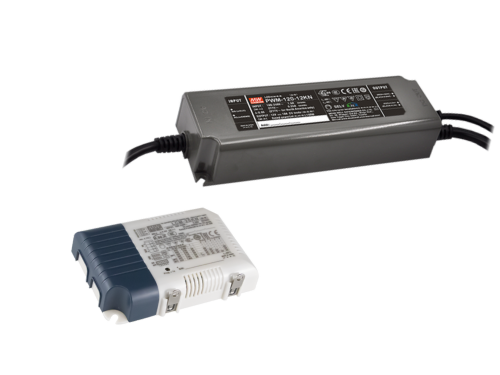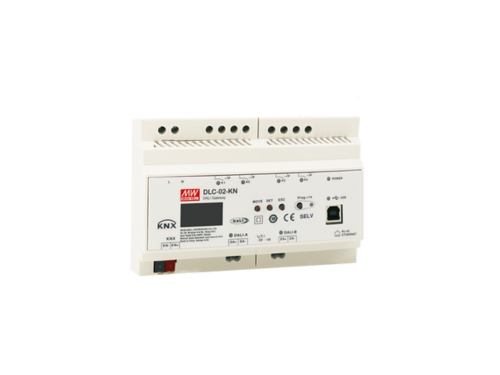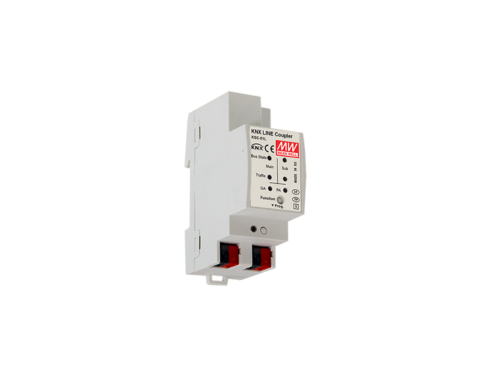Building Automation System
Building Automation System (BAS), also known as Building Management System (BMS), is an intelligent system for modern buildings. These systems offer monitoring functions and enhanced control over electrical and mechanical systems throughout a building. A Building Automation System enables users to control lighting, heating & cooling (HVAC), shutter, security, and many other applications. A well setup BAS will help to run HVAC systems and lighting system more efficiently and reduces energy consumption.
In the current market, several popular control systems exist, such as BACnet, Modbus, DALI and KNX, each with its own benefits and limitations. Depending on the purposes and objectives of the building or smart home, one control system is often customized to meet the specific demands of each situation.
One of the most complete Building automation control systems widely adopted in Europe is KNX. This system offers a uni-communication design between controllers, sensors, and actuators. KNX is specially targeting building, home automation and domotics projects and is one of the few systems which offers solutions to every automation aspect (e.g., HVAC, Acces Control, Sensors, security and lighting) in a Building Automation System.
MEAN WELL KNX PRODUCTS
MEAN WELL is the leading manufacturer of Standard Power Supplies in the market. With over 40 years of experience in the development and production of power supplies, MEAN WELL offers a wide range of high-quality KNX devices in 6 categories as below.
What are benefits of KNX?
KNX is an international recognized standard which covers every automation aspect of home and building control. This standard is adopted by more than 500 members. Some of the key benefits of KNX are:
- Excellent compatibility between KNX devices from different manufacturers
- Endless different automation solutions available in the market (over 10.000 certified KNX products are available)
- Manufacturer independent software (ETS)
- Future proof technology
- Secure system options available
- Easy integration into other BAS (sub)systems, such as Modbus, BACnet & DALI
- Large community and high acceptance rate
- Effortless installation and endless possibilities to expand
With KNX system, users are nowadays able to control all kinds of application devices under the roof of their smart building. KNX IoT (Internet of things) further allows the users to control via KNX app from mobile devices to achieve KNX wireless, which is communicated via KNX IP or KNX RF. Setting up lighting and heating of the building is easier than ever: blinds can now be shut, doors can be locked with one simple touch on the screen. Not only have living and working environments become more convenient and secure, but they are now also more energy-efficient and economical.
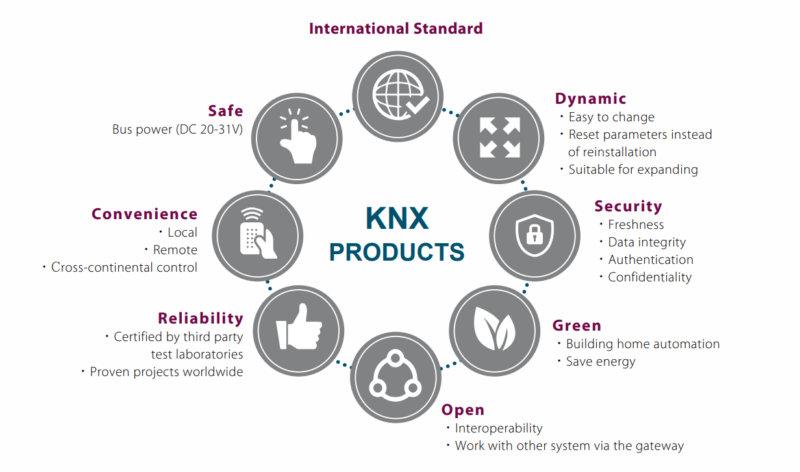
What is KNX Secure?
In response to the rising demand of data protection, KNX Secure technology is designed to protect all system data accordingly to the highest encryption standards. KNX Secure signs and encrypts the communication telegrams in the KNX network to avoid the manipulation by unauthorized access or hackers.
The KNX Secure protection is designed in two layers: KNX data secure and IP secure; the former one protects principally the user data against unauthorized access and manipulation, while the latter one aims to ensure that all communication telegrams and data are securely encrypted.
The secured communication data includes the commissioning (configuration) processes with the ETS software, as well as the runtime (daily) communication between KNX devices. The concept ensures that all or selected KNX telegrams are authenticated and encrypted regardless of the medium.
As result, the communication between sender and receiver can be neither interpreted nor manipulated.
KNX Lighting Control
The architecture of the KNX lighting system consists of KNX power supply that supplies the KNX bus and KNX switch actuator which is used to control the LED driver by simply turning on or off. In addition, a KNX presence detector can also be installed to automatically control the light when human or moving objects have been detected.
KNX lighting control systems can be divided into two types: Analog lighting systems and Digital lighting systems. Analog systems tend to be more flexible when it comes to the control over lighting devices, whereas digital lighting systems have as advantage more comprehensive control and the possibility to read out data from the KNX device directly such as power consumption and lamp failure.
Analog lighting systems are in general a combination of KNX actuator, KNX dimming actuator and/or KNX phase cut actuators. These actuators are powered and controlled via the KNX bus and can switch on/off the AC mains by means of a relay. Whereas dimming is achievable by a 0-10V/1-10V signal or by cutting of a phase.
Main advantages of these analog systems are that, in principle, any type of drivers or ballasts can be connected to the KNX actuator, and that a single KNX actuator would allow to switch on all connected fixtures, ballast and or drivers.
Disadvantages of analog systems are that additional wire installation is needed to transfer the 0-10V/1-10V signal, so different wire lengths could result in different light output of the light source, and there could be compatibility issues between KNX Phase cut actuator and phase cut driver.

Currently, there are few options available to make a direct digital lighting control in KNX (or other BAS) systems. The most common solution for a digital lighting system implementation in a BAS is by using a subsystem, and one of the most accepted digital lighting systems is DALI. DALI is an open protocol focusing on lighting control and is accepted by most lighting manufacturers. To create a subsystem in a KNX system, a KNX DALI Gateway is needed to translate KNX commands into DALI commands.
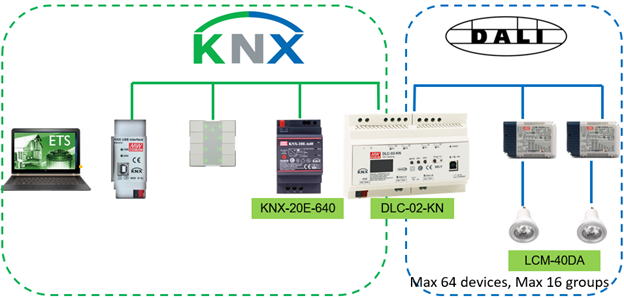
Advantages of Digital Lighting System:
- Easier installation and less wires as it is a bus system with addressable components
- Light levels can be controlled precisely and will be consistent despite the cable lengths
- Read data (Lamp failure, Power consumption)
- Emergency function
- CLO light compensation (LED’s age over the time and CLO will compensate the light output)
- Logarithmic dimmable
- Color control and complex scene setting
Disadvantages of Digital Lighting System:
- Higher cost of the components in the system
- Knowledge is needed for setting up ETS and DALI
- Additional gateway needed
- Gateway is a single point of failure
KNX Direct Digital Lighting Control
One of the drawbacks of using a subsystem for Digital lighting control is the need of gateways which generates additional costs and creates a single point of failure in a digital lighting system. Also, one would need to have the knowledge of 2 different protocols to set up the lighting system.
One should consider why using 2 different protocols when the KNX protocol has all functions to make a direct digital control over a lighting system? MEAN WELL is one of the first manufacturers offering KNX LED drivers which can be controlled directly over the KNX BUS. This is an economical solution as it simplifies the installation by using a single protocol, saving cost of KNX Dali Gateway and removing single point of failures.
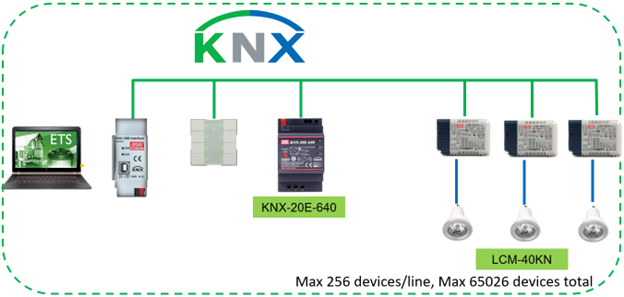
MEAN WELL KNX LED drivers are available as constant current drivers (LCM-25KN, LCM-40KN and LCM-60KN) and constant voltage dimmable LED drivers (PWM-60-KN, PWM-120-KN and PWM-200-KN) with a PWM frequency which can be setup up to 4kHz. The details of these drivers can be found here: KNX Building Automation Solution-MEAN WELL
More information about digital lighting control: Better than DALI: KNX Lighting – All About MEAN WELL Power Supplies
Blind Control with KNX
A KNX blind control or KNX shutter control system is an important element in creating an efficient energy-saving system in modern smart buildings.
Blind and shutter control systems are usually triggered by data provided by KNX Room controllers, KNX Weather stations and/or KNX Light Sensors. Based on the inputs of these devices and the settings made in the ETS software, KNX shutter actuators are triggered to set blinds and shutters in optimal positions to provide energy efficiency, shading and visual comfort.
A simple example of a blind control system is a light sensor installed to measure the sunshine radiation value of a specific indoor space. With collected data, a KNX shutter actuator is programmed via ETS software to control the shading system: when the sunshine is strong, the corresponding blinds or curtain of the wall will be closed to provide shielding, and vice versa.
KNX shutter actuators are the key element in KNX Blind control systems, ensuring the comfort of the indoor environment and promoting the energy efficiency of the smart building. For this, MEAN WELL offers the compact-sized KAA-8R which can control electrical shutter, blinds or curtains systems.
Heating and ventilation System Control with KNX
KNX is the leading system to create an intelligent controlled heating and ventilation and Air-conditioning (HVAC) system. In the market, there are many KNX HVAC solutions available, such as KNX room temperature controllers, Fan Coil controllers and temperature sensors which form the input to manage KNX heating actuators, KNX valve controls, KNX ventilator controller, actuators, and many more to manage climate and environment efficiently and comfortably inside buildings.
Efficient KNX HVAC systems can consist of a KNX temperature sensor to measure the temperature value of the office or a specific indoor space. With these values, a logic controller can control the heating system and adjust the room temperature. To meet this kind application, MEAN WELL has developed the KNX bus power supply KNX-20E and KNX-40E to provide KNX equipment power. The KNX switch actuator, KAA-8R can control the heating circuit and switch on/off the heater on the heat sink or in the underfloor heating system. Depending on the device model and parameter settings, the heating system can be controlled via switching parameters or pulse width adjustment (PWM). It is not only suitable for private residences, but also for commercial building usages, such as office buildings, schools, and hotels.

MEAN WELL KNX system product line consists of KNX power supply for KNX bus network, KNX-DALI gateway and KNX-LED drivers. For flexible building management, MEAN WELL KNX actuator can be used to control lighting and HVAC systems. MEAN WELL is the industry leader for industrial power supplies, and offers a complete portfolio of power supply solutions for smart building installations such as the compact and highly efficient HDR series in 15W/30W/60W/100W/150W. To sum up, the portfolio of MEAN WELL KNX system is the intelligent solution for networking, controlling, and powering Smart Buildings.
LEARN MORE ABOUT MEAN WELL KNX SYSYEM
Explore our blog for insightful technical notes about KNX Building Automation Applications.
Got questions?
Look at the section below to find the most frequently asked questions (with answers)
we received in Building Automation Applications.
The GTIN number can be found directly on the www.meanwell.com:

Yes, MEAN WELL products are registered in SCIP. To get such information for specific power supply, please follow the steps below:
- Go to https://echa.europa.eu/en/scip-database
- Under SEARCH option, choose „Article Identity” and write down model name e.g. RSP-1600.
- As “Identifier type (optional)”, please chose “Other”
- Click “Search” button

All the latest KNX firmware updates can be found on ETS Online Catalogue or MEAN WELL website dedicated to KNX products.
a. Got to KNX Building Automation Solution-MEAN WELL -> Downloads -> ETS Application Database

b. Click on Download button to see PDF file with all the hyperlink for specific products.

Find the latest news in the MEAN WELL APP


You can follow us on LinkedIn:

Go to:
https://www.linkedin.com/company/meanwell-europe-b-v-/
1. Click follow
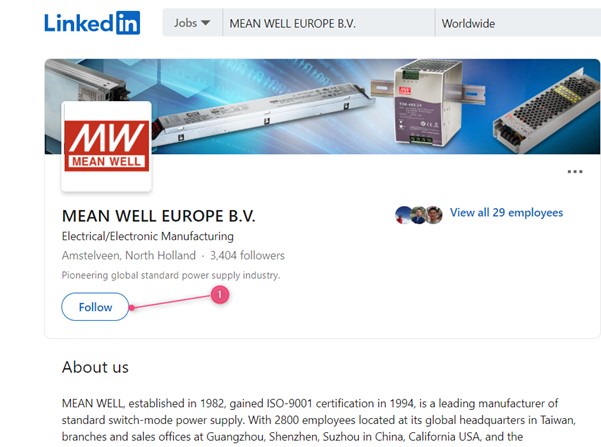
And you could install our APP see our FAQ “How to subscribe to MEAN WELL’s newsletter?”
MEAN WELL’s distributor information can be found on Distributor Network-MEAN WELL Switching Power Supply Manufacturer
- Click on the region that you are located
- Select the country you are in
- Click on the search button
- Scroll down to see our local distribution channels
- Look for the distributor with a tick for the product group that you are looking for

MEAN WELL has the largest distribution network for serving your small and medium demand Power Supplies. You can find all MEAN WELL’s distribution channels on Distributor Network-MEAN WELL Switching Power Supply Manufacturer.
OEM’s which have no sales channel for MEAN WELL products yet can contact us via the “Contact Us” form on this website.
MEAN WELL’s discontinued product schedule and End of Life products are normally updated 2 times per year, in January and in July and are published on www.meanwell.com. See FAQ “Where can I find MEAN WELL’s discontinued product schedule and End of Life information? “
The normal procedure for E.O.L. is:
- The product or series is announced in the Discontinued product list in January or July and announced as NRND (Not Recommend for New Design)
- 6 months later the lead time of the product or series will increase +30 days, the price will increase as well.
- Another 6 months later, the lead time will increase another +30 days (so + 60day compared to the original lead time), the price will increase again.
- Another 6 months later, the lead time will increase another +30day (so +90 days compared to the original lead time) and the price will increase again and additionally there will be a MOQ of 200pcs (and steps of 100 for higher quantities)
- After another 6 months the last buy is announced on the website. This will be the last opportunity to place an order for this product or series.
In total MEAN WELL’s End of Life, procedure will take 2 years. However, there are situations for instance that certification is expired, or some components can no longer be obtained by the market which will force to accelerate the EOL schedule. Therefore, it is always highly recommended from the moment that a product is on the discontinued list to design in one of our new generation products. If need any advice to this, please use the “Contact Us” function on this website.
MEAN WELL’s discontinued product schedule and End of Life products are normally updated 2 times per year, in January and in July. To see the full list, go to www.meanwell.com
1. Click on products
2. Click on Discontinued products for the schedule for the EOL schedule
Click on EOL for the MEAN WELL products which are End Of Life

You can use the “Contact Us” function on this website
MEAN WELL’s website provides you all the basic information about our Power Supplies. This includes company news, product announcements, ISO certificates, Specifications, test report, Certificates, ROHS declarations, Reach declarations and many more.
MEAN WELL’s products can be found on www.meanwell.com
1. Click on products and select the product category

Or in case you already have a part number, you can use the search function on the website:
2. Use the search function on the website to find the right product
3. Fill in the series number in the search field (do not include the last extensions such as -12 in XLG-150-12)
4. Click the search button

5. Click on the PDF icon to open the specification

MEAN WELL has incorporated dust proofing and waterproofing into the majority of its LED power supply design. Mainly based on the international standard IEC60529, detailed descriptions can be found in the following table:
(Note: PSUs with IP64 rating or above are suitable for indoor or outdoor applications in sheltered locations)
IP xy protection level
| Degree of protection, foreign bodies (x) | Degree of protection, moisture(y) |
| 0. Not protected 1. Solid foreign object (>50mm) 2. Solid foreign object (>12mm) 3. Solid foreign object (>2.5mm) 4. Solid foreign objects of 1,0mm diameter and greater 5. Amount of dust that would interfere with normal operation Dust tight | 0. Not protected 1. Vertically falling water drop 2. Vertically falling water drop when enclosure is tilted up to 15 degrees 3. Water sprayed at an angle up to 60o on either side of the vertical 4. Water splashed against the component from any direction 5. Water projected in jets from any direction (12.5 liter/minute) 6. Water projected in powerfil jets from any direction (100 liter/minute) 7. Temporary immersion in water ( 1 meeter from the surface of the water for 30 minutes) 8. Continuous immersion in water, or as specified by the user / manufacture |
*IP64-IP66 level products are suitable for damp indoor or sheltered outdoor environment. For actual installation limitations, please refer to the corresponding IP level tests.
*All products cannot be continuously submerged in water.
*The definition of IP68 by MEAN WELL: Immerse a unit under test in 1 meter below the surface of the water, tested with a dynamic condition where 12-hour AC on; 12-hour AC off.
Test duration: 1 month.
LED Drivers are recommended operate at full load as long as it observes the working temperature specified in the datasheet, which means Tc measurement results should be equal to or less than the stated Tc in the datasheet. 5 years warranty complies as long as drivers operate within working Temperature and Tc. Limit as well.
No, they are different. SELV means the LED driver will use a safety isolating transformer with double or reinforced insulation and the output voltage shall not exceed 120Vdc.
This is good for the end product safety certified if the LED driver with SELV output.
The definition of SELV was defined in the IEC 60950 standard but it is not defined in the IEC 62368 standard. This has been replaced with the ES1 Energy sources definition.
The definition of SELV is still applicable to the 61347-2-13 standard. In this standard it is that a LED driver will use a safety isolating transformer with double or reinforced insulation and the output voltage shall not exceed 120Vdc.
In the specification MEAN WELL’s 61347-2-13 certified LED drivers are marked with the SELV symbol in the case that the SELV requirements are fulfilled:
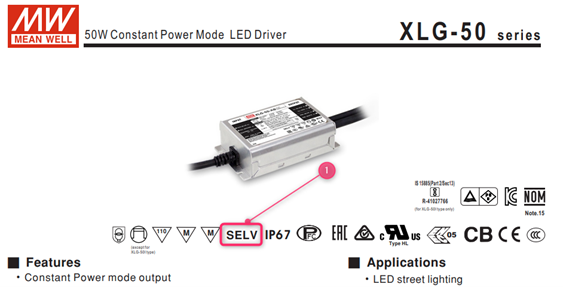
MEAN WELL’s safety reports, IEC reports and CB reports are not available online. In case you need these reports to validate your design with your certifying body, please contact your local MEAN WELL sales channel for support. If you are unable to get the support, please contact us via this website.
MEAN WELL’s User Manual can be found on www.meanwell.com
1. Go to products
2. Click on Installation Manual

3. Scroll down to find the user manuals for the different product families.

MEAN WELL’s Safety certifications can be found on www.meanwell.com
- Use the search function on the website
- Fill in the series number in the search field (do not include the last extentions suchs as -12 in XLG-150-12
- Click the search button

4. Click on the PDF Link

5. Click on the top on the certificate
6. All available certificates are shown and will show up once clicked upon

MEAN WELL’s CE declarations can be found on www.meanwell.com
- Use the search function on the website
- Fill in the series number in the search field ( do not include the last extentions suchs as -12
- Click the search button

4. Click on the PDF Link

5. Click on the top on certificate
6. Click on CE declaration

Select (1) Products followed by (2) downloads
MEAN WELL’s EMI test guide can be found on www.meanwell.com
Select (1) Products followed by (2) Downloads

After this scroll down to find the EMI testing of Power guide

Or you can use this link to directly download the EMI testing guide:
EMI_statement_en.pdf
MEAN WELL’s RoHS and Reach statements can be found on www.meanwell.com
Select (1) Products followed by (2) Downloads:

After this scroll down to find the RoHS declaration and Declaration of SVHC/ REACH conformity:

Or you can use the below links to download the declarations:
MEAN WELL’s Declaration of Conflict Free Minerals can be found on www.meanwell.com
Select (1) Products followed by (2) Downloads

After this scroll down to find the Declaration of Minerals Conflict Free

Or you can use this Link to directly download the EMI testing guide:


